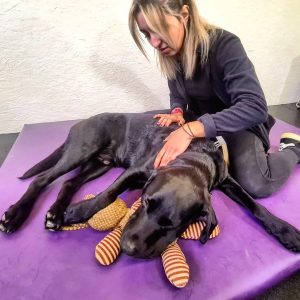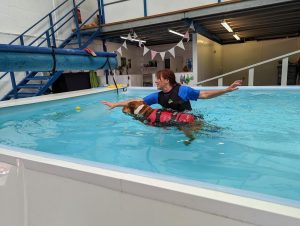There isn’t a one size fits all approach to rehabilitation but one critical factor is how long tissue takes to heal. We’re talking here about muscle, bone, tendons, ligaments and cartilage, all of which heal differently.
A thorough understanding of tissue healing allows us to treat your dog appropriately; to know whether to stimulate or suppress inflammation, to ensure sufficient rest and minimise stress during repair, and what level of progressive stress to add during remodelling.
There are three phases of healing which are all slightly different for different tissue:
- The inflammatory phase
- The reparative phase
- The remodelling or maturation phase

The Inflammatory Phase
Inflammation is the first phase of wound healing and is essential for healing to occur. If the inflammatory phase is too short or too long, healing will be impaired.
The inflammatory phase starts with a vascular response that creates a balanced state in the body. If a wound is formed, blood vessels are disrupted, this leads to bleeding and the presence of blood between cells. When the blood coagulates it essentially creates a plug.
Within six hours cells infiltrate the wound cleaning it and preventing contamination, then within 24 to 48 hours more cells appear to start the next stage of healing – the repair stage. Wounds need to transition from inflammation to the reparative phase after two to three days.
This transition phase is important when choosing which modalities we use for treatment. We don’t want to suppress the inflammatory phase, but in some tissue we will benefit the body if we can speed it up. Tissues like tendons and ligaments have a very limited inflammatory phase, and we’ll want to be very cautious about anything that might suppress this phase.
Reparative Phase
The reparative phase starts off within three days of injury, and is followed by something known as matrix synthesis. This phase can last for around 2 to 3 weeks.
Using collagen, elastin and proteoglycans the matrix synthesis slowly starts to increase the tensile strength of the area. As a cellular level scaffold forms, new capillaries grow into the area until a normal oxygen level is achieved in the tissue.
During this phase it is essential to protect the tissue from any stress that might widen the wound, as that would delay healing and cause scarring, which reduces tensile strength in the tissue. We need to be especially cautious with any therapeutic exercise at this point.
Remodelling Phase
In the remodelling phase, cellular fibres progressively align themselves parallel to the lines of stress and strain. As they align, crosslinks form between them to create a stable formation. This process is essential if the tissue is to regain its original tensile strength, making rehabilitation during this phase critical.
If the incorrect stresses are placed on the tissue, fibrous tissue might dominate this phase and tensile strength will never be regained. Guidance of a qualified therapist is therefore absolutely critical.
Our therapeutic exercise becomes so important in the remodelling phase. Rehab is more than just therapeutic exercise. It is imperative that we know and understand how each of our therapeutic modalities impact on tissue and healing, so that we can use the modalities correctly and at the appropriate phase of healing. This includes everything from the application of heat and ice, to massage, to therapeutic ultrasound and laser, and all the modalities in between. All of these modalities have different effects on tissues, depending on which type of tissue we’re dealing with.
So, how long does healing actually take?
Below is a table of the average healing times of different tissues:
Muscle Strain
| Grade 1 | Grade 2 | Grade 3 |
| 2-8 Weeks | 2-4 Months | 9-12 Months |
Ligament Strain
| Grade 1 | Grade 2 | Grade 3 | Graft |
| 2-8 Weeks | 2-6 Months | 6-12 Months | 12+ Months |
Tendon Injury
| Acute | Subacute | Chronic | Tear/Rupture |
| 2-6 Weeks | 2-4 Months | 3-9 Months | 4-12 Months |
Other Injuries
| Bone/Fracture | Articular Cartilage | Meniscus/Labrum |
| 6-12+ Weeks | 9-24 Months | 3-12 Months |
A bit more information on the terms we’ve used above:
- Acute: Indicates very sudden onset or rapid change
- Chronic: Indicates indefinite duration or virtually no change
- Grade 1: Mild damage to individual muscle fibres (less than 5% of fibres) that causes minimal loss of strength and motion
- Grade 2: More extensive damage with more muscle fibres involved. However, the muscle is not completely ruptured. These injuries present with significant loss of strength and motion
- Grade 3: Complete rupture of a muscle or tendon. These can present with a palpable defect in the muscle or tendon. However, swelling in the area may make this difficult to appreciate
- Graft: The transplant of a living piece of tissue as a surgical repair
- Subacute: Indicates a recent onset or somewhat rapid changing condition
With thanks to River Veterinary Rehabilitation Centre for compiling the above time frames.













